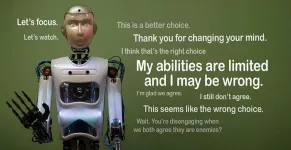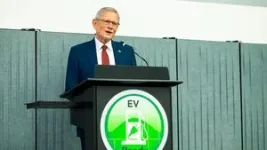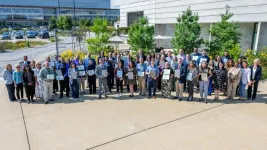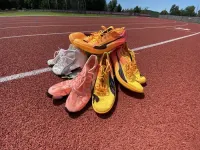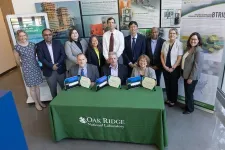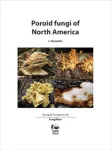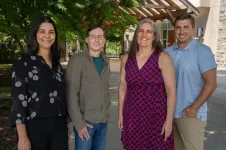(Press-News.org) In simulated life-or-death decisions, about two-thirds of people in a UC Merced study allowed a robot to change their minds when it disagreed with them -- an alarming display of excessive trust in artificial intelligence, researchers said.
Human subjects allowed robots to sway their judgment despite being told the AI machines had limited capabilities and were giving advice that could be wrong. In reality, the advice was random.
“As a society, with AI accelerating so quickly, we need to be concerned about the potential for overtrust,” said Professor Colin Holbrook , a principal investigator of the study and a member of UC Merced’s Department of Cognitive and Information Sciences . A growing amount of literature indicates people tend to overtrust AI, even when the consequences of making a mistake would be grave.
The results varied slightly by the type of robot used. In one scenario, the subject was joined in the lab room by a full-size, human-looking android that could pivot at the waist and gesture to the screen. Other scenarios projected a human-like robot on a screen; others displayed box-like ’bots that looked nothing like people.
Subjects were marginally more influenced by the anthropomorphic AIs when they advised them to change their minds. Still, the influence was similar across the board, with subjects changing their minds about two-thirds of the time even when the robots appeared inhuman. Conversely, if the robot randomly agreed with the initial choice, the subject almost always stuck with their pick and felt significantly more confident their choice was right.
(The subjects were not told whether their final choices were correct, thereby ratcheting up the uncertainty of their actions. An aside: Their first choices were right about 70% of the time, but their final choices fell to about 50% after the robot gave its unreliable advice.)
Before the simulation, the researchers showed participants images of innocent civilians, including children, alongside the devastation left in the aftermath of a drone strike. They strongly encouraged participants to treat the simulation as though it were real and to not mistakenly kill innocents.
Follow-up interviews and survey questions indicated participants took their decisions seriously. Holbrook said this means the overtrust observed in the studies occurred despite the subjects genuinely wanting to be right and not harm innocent people.
Holbrook stressed that the study’s design was a means of testing the broader question of putting too much trust in AI under uncertain circumstances. The findings are not just about military decisions and could be applied to contexts such as police being influenced by AI to use lethal force or a paramedic being swayed by AI when deciding who to treat first in a medical emergency. The findings could be extended, to some degree, to big life-changing decisions such as buying a home.
“Our project was about high-risk decisions made under uncertainty when the AI is unreliable,” he said.
The study’s findings also add to arguments in the public square over the growing presence of AI in our lives. Do we trust AI or don’t we?
The findings raise other concerns, Holbrook said. Despite the stunning advancements in AI, the “intelligence” part may not include ethical values or true awareness of the world. We must be careful every time we hand AI another key to running our lives, he said.
“We see AI doing extraordinary things and we think that because it’s amazing in this domain, it will be amazing in another,” Holbrook said. “We can’t assume that. These are still devices with limited abilities.”
What we need instead, Holbrook said, is a consistent application of doubt.
“We should have a healthy skepticism about AI,” he said, “especially in life-or-death decisions.”
The study, published in the journal Scientific Reports, consisted of two experiments. In each, the subject had simulated control of an armed drone that could fire a missile at a target displayed on a screen. Photos of eight target photos flashed in succession for less than a second each. The photos were marked with a symbol – one for an ally, one for an enemy.
“We calibrated the difficulty to make the visual challenge doable but hard,” Holbrook said.
The screen then displayed one of the targets, unmarked. The subject had to search their memory and choose. Friend or foe? Fire a missile or withdraw?
After the person made their choice, a robot offered its opinion.
“Yes, I think I saw an enemy check mark, too,” it might say. Or “I don’t agree. I think this image had an ally symbol.”
The subject had two chances to confirm or change their choice as the robot added more commentary, never changing its assessment, i.e. “I hope you are right” or “Thank you for changing your mind.”
END
Study: People facing life-or-death choice put too much trust in AI
2024-09-04
ELSE PRESS RELEASES FROM THIS DATE:
Leaders of ‘EV Ready’ Illinois cities recognized in ceremony at Argonne
2024-09-04
City leaders who are working to accommodate more electric vehicles (EVs) were recognized in a ceremony o Aug. 23 at the U.S. Department of Energy’s (DOE) Argonne National Laboratory. Utility ComEd and the Metropolitan Mayors Caucus spotlighted 12 communities in northern Illinois that recently completed the EV Readiness Program.
The EV Readiness Program trains and assists local government officials in taking concrete steps to support EV adoption. As a national leader in EV research, ...
Survey shows nearly 70% of US hospitals affiliated with medical schools host a fast-food restaurant; Chick-fil-A, McDonald’s among most common
2024-09-04
WASHINGTON, D.C.—A new survey by the Physicians Committee for Responsible Medicine published in the American Journal of Lifestyle Medicine reveals that 69.2% of U.S. hospitals affiliated with a medical school host at least one fast-food restaurant. The five most common fast-food restaurants located in hospitals were Starbucks, Subway, Chick-fil-A, Au Bon Pain, and McDonald’s.
“Making fast food like cheeseburgers and fried chicken available in hospitals is hazardous to the health of patients, visitors, and staff,” says Zeeshan Ali, PhD, the lead author of the paper and a nutrition program specialist with the Physicians Committee. “Hospitals ...
Study solves testosterone’s paradoxical effects in prostate cancer
2024-09-04
DURHAM, N.C. – A treatment paradox has recently come to light in prostate cancer: Blocking testosterone production halts tumor growth in early disease, while elevating the hormone can delay disease progression in patients whose disease has advanced.
The inability to understand how different levels of the same hormone can drive different effects in prostate tumors has been an impediment to the development of new therapeutics that exploit this biology.
Now, a Duke Cancer Institute-led study, performed ...
New UMass study shows that ‘super spikes’ can increase track running speed by 2%
2024-09-04
New research published in the Journal of Sport and Health Science led by the University of Massachusetts Amherst shows that super spikes, scientifically described as advanced footwear technology (AFT) spikes, can give runners about a 2% edge in middle-distance track races, like the 800- and 1,500-meters.
“Track athletes started wearing super spikes about five years ago and they are now commonplace in elite track races,” says Wouter Hoogkamer, assistant professor of kinesiology at UMass Amherst and senior author ...
Department of Energy announces $118 million for Energy Frontier Research Centers
2024-09-04
WASHINGTON, D.C. -Ten Energy Frontier Research Centers (EFRCs) designed to bring together world-class teams of scientists for groundbreaking fundamental research have been funded in nine states by the U.S. Department of Energy (DOE).
Since 2009, EFRCs have brought together diverse, world-class teams of scientists to perform basic research that accelerates ground-breaking scientific advances underlying energy technologies.
The centers develop powerful new tools for characterizing, understanding, modeling, and manipulating matter, while training the next-generation scientific workforce by attracting talented students passionate about energy science.
“Fundamental ...
ACC Quality Summit highlights critical value of ACC accreditation and NCDR services
2024-09-04
The American College of Cardiology (ACC) Quality Summit 2024 will take place on September 17-19 in San Antonio, bringing together cardiovascular leaders from across the nation to discuss the value of NCDR services and quality programs.
“ACC’s Quality Summit puts the spotlight on the value of ACC Accreditation and NCDR services for improving health care quality across all health systems,” said ACC Quality Summit Chair Olivia N. Gilbert, MD, MSc, FACC, and Director of Quality and Value for Cardiovascular Medicine at Atrium Health Wake Forest ...
Coatings manufacturer and ORNL partner Flexcon licenses self-healing film technology
2024-09-04
Flexcon Global has exclusively licensed two patented inventions to manufacture a self-healing barrier film from the Department of Energy’s Oak Ridge National Laboratory for research and development purposes. The film can be incorporated into vacuum insulation panels to increase the efficiency of buildings during retrofits.
Flexcon, based in Spencer, Massachusetts, provides coatings, film laminations and functional technologies to a range of markets including healthcare, sustainable packaging, transportation, consumer durables, electronics, industrial, retail and advertising.
Under ...
A new, updated account of poroid fungi in North America
2024-09-04
Poroid fungi, commonly known as "polypores," are among the most frequently encountered fungi throughout the year because of their large size and longevity. Despite the common presence of poroid fungi in North America, most guides include only a limited selection of these fungi. Poroid Fungi of North America, by Leif Ryvarden, offers a necessary, updated account of these fungi, building on the foundational work of the original two-volume North American Polypores, by Ryvarden and R. L. Gilbertson, published in 1987. This comprehensive update incorporates more than three decades of new research, featuring detailed keys, descriptions, and vibrant color ...
Collaborative research to benefit coastal flounder populations and fishers
2024-09-04
Four faculty members from three departments in the College of Natural Resources and Environment have received $1.7 million from the National Science Foundation to fund research into the dynamics of socio-environmental factors impacting coastal fisheries.
Holly Kindsvater and Willandia Chaves of the Department of Fish and Wildlife Conservation, Craig Ramseyer of the Department of Geography, and Michael Sorice of the Department of Forest Resources and Environmental Conservation will collaborate with Jonathan van Senten and Fernando Gonçalves of the Virginia Seafood Agricultural Research ...
WashU scientists uncover hidden source of snow melt: Dark brown carbon
2024-09-04
Wildfires leave potent climate heaters behind in their wake, particles that enhance the absorption of sunlight and warm the atmosphere. Dropped on snow like a wool poncho, these aerosols darken and decrease the surface reflectance of snowy places.
But it was not yet understood just how different types of smoke particles contribute to these effects. In a study recently published in npj Climate and Atmospheric Science, researchers at Washington University in St. Louis model how dark-brown carbon (d-BrC) – light absorbing, water insoluble organic carbon – from wildfires plays a much larger role as a snow-warming agent than previously recorded. ...
